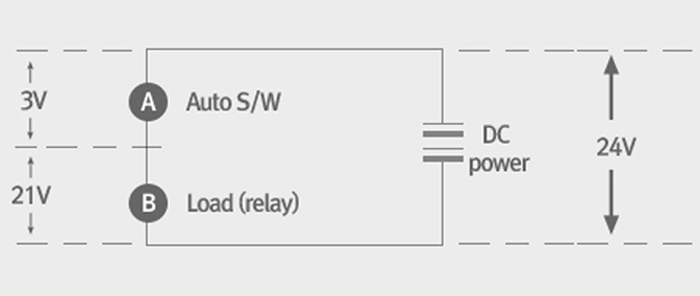Saewon Electronics produces products with the quality and performance desired by customers
Terminology
1) Working voltage
It means the voltage of power that is applied to Auto S/W and load(relay, PLC, S.V, etc.) in series. If working voltage is higher than standard value, Auto S/W and load may be damaged and if it is lower than standard value, Auto S/W lamp and load do not operate normally.
※ Caution: If power source is connected to Auto S/W directly, power source is damaged.
2) Working current
Working current means the maximum current that can flow in Auto S/W. If the current is higher than standard value, Auto S/W may be damaged and if the current is lower than standard value, lamp is not turned on and load do not operate normally.
3) Response speed
It means the speed that Auto S/W can respond within given time.
EX) : 1msec → Operation of 1000 times for 1 second
500Hz → Operation of 500 times for 1 second
3000R.P.M - Operation of 3000 times for 1 minute
4) Hysteresis character
In Auto S/W, hysteresis character means the status that On range of Auto S/W is overlapped with its Off range. If magnetic substance is turned on when it is 5mm far from Auto S/W, it shall be turned off when it is 5.1mm far from it. Here, however, it should be turned off when it is 6mm far from it. If hysteresis is not sufficient, chattering phenomenon occurs and if it is too excessive, operation scope becomes unnecessarily wide.
5) Contact point protection circuit
When L load (relay, MG, S.V) is changed from On condition into Off condition, counter electromotive force is generated instantly, giving damage to intemal parts of Auto S/W. Contact point protection circuit means the circuit to protect contact point by inserting the element that can absorb counter electromotive forcelcondenser, zener and varistor) internally. Generally, surge absorber is inserted to a large Auto S/W (D-A54, D-50, RO, etc.) but there is no surge absorber in a small Auto S/W.
6) Internal voltage drop
Intemal voltage drop means the voltage consumed by Auto S/W.
i. As you see in the picture, voltage is 24V and intemal voltage drop of Auto S/W is 3V so the voltage that is actually applied to load is 21V
ii. If Auto S/W consists of several AND circuits(serial circuits), load does not operate because of intemal voltage drop. If 3 Auto S/Ws are connected in series, 3V X 3V = 9V so only 15V is applied to load.
iii. In OR circuit (parallel circuit), intemal voltage drop does not depend on the number of Auto S/Ws but just 1 internal voltage drop occurs so there is no problem although several Auto S/Ws are connected.
7) Internal resistance
It means the intemal resistance of Auto S/W. For example, it means the resistance combined with contact resistance of lead switch and semiconductor (choke coil, diode and resistance). There is a difference between forward resistance and reverse resistance.
